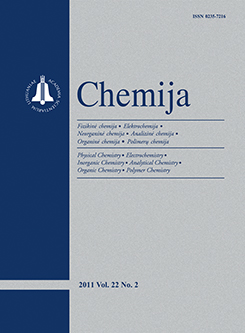 ISSN 0235-7216 ISSN 2424-4538 (online) |
2009 m. Nr. 1 Modification of polyamide films by copper chalcogenide layers with the use of potasium selenopentathionate
Selenopentathionate anions are sorbed–diffused into polyamide films treated with solutions (0.025–0.2 mol · dm–3, 30–50 °C) of potassium selenopentathionate, K2SeS4O6, not acidified or acidified with hydrochloric acid. Sorption–diffusion from acidified solutions proceeds more intensively: the concentrations of selenium and sulfur diffused from an acidified solution are about 5 times higher as compared with those obtained using a non acidified solution of the same concentration and at the same temperature. The concentration of sorbed selenopentathionate ions increases with increasing the temperature and concentration of K2SeS4O6 solution and the duration of treatment. The SeS4O62– anions diffused into polyamide gradually decompose, and the decomposition products – sulfate ions and SO2 – are washed out from the polymer, but elemental selenium remains in it. Therefore, the polyamide films, depending on the degree of SeS4O62– ion decomposition, change from colourless to yellow, brown or red. Copper sulfide and copper selenide layers are formed in the surface of polyamide film if the chalcogenized polymer is treated with a water solution of copper(II / I) salt: the anionic particles containing sulfur and selenium atoms of low oxidation state react with the copper ions. The conditions of polymer initial chalcogenation (the concentration and temperature of K2SeS4O6 solution) determine the amount of copper and the composition of chalcogenide layer: the content of copper in the polyamide film increases with an increase of the concentration and temperature, and varies from 0.2 · 10–2 to 33.5 · 10–2 mg/cm2. Results of X-ray structural analysis confirmed formation of mixed copper sulfide – copper selenide layers in polyamide surface. The phase composition of the layer changes depending on the duration of initial treatment in K2SeS4O6 solution: CuxS–CuySe layers are composed of the low-conductive chalcocite, Cu2S, electrically conductive digenite, Cu1.8S, djurleite, Cu1.9375S, anilite, Cu1.75S, and of copper selenides – bellidoite, Cu2Se, umangite, Cu3Se2, klockmannite, CuSe, krutaite, CuSe2 and Cu2Sex. Therefore, the phase composition determines the electrical characteristics of the layers: their sheet resistance may vary from 12.2 Ω / □ to 4.8 MΩ / □. The determination of layer composition (to a depth of 1 nm) studied by the method of X-ray photoelectron spectroscopy confirmed the formation of copper sulfides and selenides of various phases. The determined regularities enable formation by the sorption–diffusion method of mixed copper sulfide and copper selenide layers of a desirable composition and electrical conductance, using selenopentathionate as a polyamide chalcogenation agent. Keywords: selenopentathionate, polyamide, sorption-diffusion, copper chalcogenides layers |
Issues:
2017 - Vol.28 No. 1, No. 2, No. 3, No. 4 2016 - Vol.27 No. 1, No. 2, No. 3, No. 4 2015 - Vol.26 No. 1, No. 2, No. 3, No. 4 2014 - Vol.25 No. 1, No. 2, No. 3, No. 4 2013 - Vol.24 No. 1, No. 2, No. 3, No. 4 2012 - Vol.23 No. 1, No. 2, No. 3, No. 4 2011 - Vol.22 No. 1, No. 2, No. 3, No. 4 2010 - Vol.21 No. 1, No. 2-4 2009 - Vol.20 No. 1, No. 2, No. 3, No. 4 2008 - Vol.19 No. 1, No. 2, No. 3-4 2007 - Vol.18 No. 1, No. 2, No. 3, No. 4 2006 - Vol.17 No. 1, No. 2-3, No. 4 2005 - Vol.16 No. 1, No. 2, No. 3-4 2004 - Vol.15 No. 1, No. 2, No. 3, No. 4 2003 - Vol.14 No. 1, No. 2, No. 3, No. 4 2002 - Vol.13 No. 1, No. 2, No. 3, No. 4 2001 - Vol.12 No. 1, No. 2, No. 3, No. 4 |